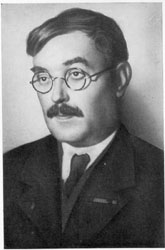Scientist that have contributed to the understanding of the structure of complex many electron-atoms are:




W. Pauli, J.C. Slater, D.R. Hartree, and V.A. Fock
 All constituting particles have their three degrees of freedom complicating
immensely the solution of the Schrödinger equation:
exact solutions cannot be found.
All constituting particles have their three degrees of freedom complicating
immensely the solution of the Schrödinger equation:
exact solutions cannot be found. A fundamental theorem of quantum mechanics related to the indistinguishability
of particles (here the electrons) comes into play: this gives restrictions on the
wave functions.
A fundamental theorem of quantum mechanics related to the indistinguishability
of particles (here the electrons) comes into play: this gives restrictions on the
wave functions. Approximate treatments of the Schrödinger equation
Approximate treatments of the Schrödinger equationThe underlying physical problem of the complex atom is that the electrons, distibuted in the atom, undergo electrostatic repulsion. All electrons are attracted to the nucleus by a central Coulomb force by a charge +Ze, similar as in the hydrogen atom. The repulsive force between the electrons, represented by a potential Vee involves the spatial coordinates of all electrons and is not centrally directed.
 In a simplified picture the binding energy can be calculated for the helium atom,
involving two electrons. The binding of two electrons in the central field of a +2e
nucleus adds to eight equivalents of Rydberg energies. If the two electrons
are assumed to stay at an average distance of 2 Bohr radii the repulsive
energy is 2 Rydberg equivalents. This simple model
(read)
gives almost the correct binding energy of -79 eV for the helium atom.
Of course no two-electron wave functions can be derived in this way.
For the helium atom variational calculations
(
see the variational priniple)
can be
performed that predict the binding energies of the quantum levels
up to 10 digits or more.
In a simplified picture the binding energy can be calculated for the helium atom,
involving two electrons. The binding of two electrons in the central field of a +2e
nucleus adds to eight equivalents of Rydberg energies. If the two electrons
are assumed to stay at an average distance of 2 Bohr radii the repulsive
energy is 2 Rydberg equivalents. This simple model
(read)
gives almost the correct binding energy of -79 eV for the helium atom.
Of course no two-electron wave functions can be derived in this way.
For the helium atom variational calculations
(
see the variational priniple)
can be
performed that predict the binding energies of the quantum levels
up to 10 digits or more. The effects of the non-central potential Vee is treated in the
Central Field Approximation model.
Also a
formal treatment can be given.
The effects of the non-central potential Vee is treated in the
Central Field Approximation model.
Also a
formal treatment can be given.Here the Z(Z-1)/2 repulsive electrostatic contributions in Vee are replaced by a single effective central potential V(r). In this model the attractive potential (with +Ze) due to the nucleus and the repulsive potential (due to the sum of the electrons) is taken as one Coulomb potential that scales as Zeff.
So each electron sees a screened charge Zeff, which is:
- at large distance Zeff = 1
- at short distance, near the nucleus Zeff = Z
Note that as a consequence electrons in orbitals with differing l quantum numbers undergo different screening:
- they come closer to the nucleus (low l numbers)
- or they stay away (high l numbers)
The screened charge distribution Zeff can be written as a radially dependent function Zeff(r). So the potential is no longer purely Coulombic ! This is the reason why electron energies depend on the orbital angular momentum.


 Slater developed a method to derive screening constants and calculate the binding
energies of electrons in various quantum states within the atom.
Slater developed a method to derive screening constants and calculate the binding
energies of electrons in various quantum states within the atom.Slater's rules
These rules can also be applied to calculate Atomic radii.


 Hartree and Fock developed the self-consistent field method to numerically calculate
wave functions and energies in multi-electron systems. Particulerly sice the
availability of powerful computers ab initio calculations
of atomic (and molecular) structure has become feasible.
Hartree and Fock developed the self-consistent field method to numerically calculate
wave functions and energies in multi-electron systems. Particulerly sice the
availability of powerful computers ab initio calculations
of atomic (and molecular) structure has become feasible.Self-consistent field method
 The aufbau principle for the Periodic system
The aufbau principle for the Periodic systemThe electronic structure of many-electron systems is based on the following ingredients:
 A calculation of the electronic orbitals in the central field model; note that the
level energies do depend on the quantum number l as discussed.
A calculation of the electronic orbitals in the central field model; note that the
level energies do depend on the quantum number l as discussed. Filling of these one-electron orbitals with the number of electrons in the atom,
taking into account
Pauli's exclusion principle
that no two electrons can occupy the same state.
Shells are defined for each principal quantum number n with a degeneracy
factor 2n2.
Filling of these one-electron orbitals with the number of electrons in the atom,
taking into account
Pauli's exclusion principle
that no two electrons can occupy the same state.
Shells are defined for each principal quantum number n with a degeneracy
factor 2n2. For filled shells L = S = 0.
(read proof)
Hence only the electrons outside filled shells will contribute to
the angular momentum of the atom.
This shell-filling procedure is called the
Aufbau principle.
Note that this procedure holds for the electronic
ground states of the atoms.
Note that 2, 10, 18, 36 and 54 are the magic numbers associated with filled shells.
It is not always clear what the lowest orbital is, particlarly when filling 3d and 4s orbitals
that are almost energetic, depending on the specific Z number.
There is some irregularity, because of this, for chromium.
For filled shells L = S = 0.
(read proof)
Hence only the electrons outside filled shells will contribute to
the angular momentum of the atom.
This shell-filling procedure is called the
Aufbau principle.
Note that this procedure holds for the electronic
ground states of the atoms.
Note that 2, 10, 18, 36 and 54 are the magic numbers associated with filled shells.
It is not always clear what the lowest orbital is, particlarly when filling 3d and 4s orbitals
that are almost energetic, depending on the specific Z number.
There is some irregularity, because of this, for chromium. In this way the elements can be ordered according to their shells in the
Periodic Table of the Elements.
See also the
Web-elements version.
The elements in column have the same number of electrons in the outer shell and
also have the same angular momentum in the ground state configuration.
The elements in the rightmost column, the noble gases, have filled shells.
In this way the elements can be ordered according to their shells in the
Periodic Table of the Elements.
See also the
Web-elements version.
The elements in column have the same number of electrons in the outer shell and
also have the same angular momentum in the ground state configuration.
The elements in the rightmost column, the noble gases, have filled shells. Another consequence of the Pauli principle for electrons
Another consequence of the Pauli principle for electronsThe Pauli exclusion principle was used already as the ordering principle for the construction of the Peirodic table. The concept of indistinguishability has however some deeper consequences for atomic structure. Study Electron Asymmetry (Brehm and Mullin 9-5) and the consequences for the helium atom (Brehm and Mullin 9-6).
 Ortho- and parahelium
Ortho- and parahelium Helium spectrum
Helium spectrum
 The alkali atoms
The alkali atoms Spin-orbit interaction in many-electron systems.
(read)
Spin-orbit interaction in many-electron systems.
(read)
 Lithium energy levels
Lithium energy levels Na energy levels and spectrum
and an interesting experiment to show the yellow Na-emission from an electrocuted pickle.
Na energy levels and spectrum
and an interesting experiment to show the yellow Na-emission from an electrocuted pickle.
 Various couplings, Term values and Hund's rules
Various couplings, Term values and Hund's rules LS-Coupling
LS-Coupling Spin-orbit coupling
Spin-orbit coupling JJ-coupling
JJ-coupling Term values and
Hund's rules
Term values and
Hund's rules Last change: 21 February 2001
Last change: 21 February 2001